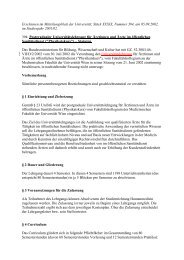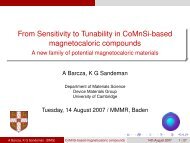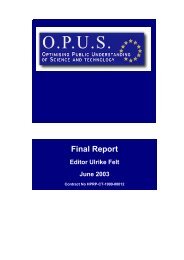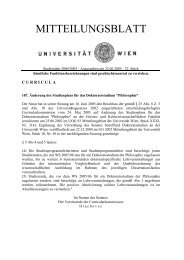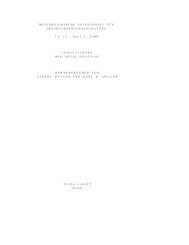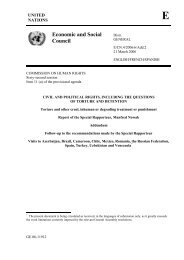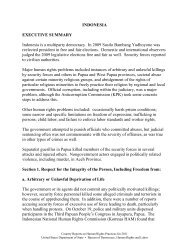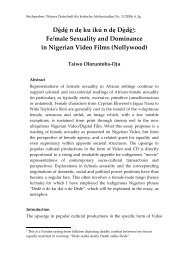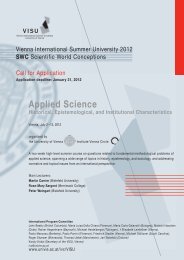(Stand: 25. Juli 2007) ANDERSON, Michael Alan ... - Universität Wien
(Stand: 25. Juli 2007) ANDERSON, Michael Alan ... - Universität Wien
(Stand: 25. Juli 2007) ANDERSON, Michael Alan ... - Universität Wien
Create successful ePaper yourself
Turn your PDF publications into a flip-book with our unique Google optimized e-Paper software.
MEDIEVAL & RENAISSANCE MUSIC CONFERENCE <strong>2007</strong> – WIEN, 7.-11. AUGUST ABSTRACTS<br />
der Wissenschaften – Kabinett der historischen Buchbestände). Neu erfasst, komparativ<br />
ausgewertet und bearbeitet wurden insgesamt 69 nummerierte Fragmente.<br />
Da in der Slowakei nur eine kleine Anzahl vollständig erhaltener notierter Kodizes<br />
erhalten geblieben ist, betrachten wir die Erfassung, Identifizierung, Analyse und Auswertung<br />
von fragmentarisch erhaltenen Handschriften als eine sehr wichtige Aufgabe der<br />
Erforschung des musikalischen Mittelalters. So konnten gegen Ende des Jahres 2005 275<br />
mittelalterliche notierte Kodizes oder Fragmente vom Gebiet der Slowakei erfasst werden,<br />
im Jahre 2006 belief sich die Zahl der neu erfassten Fragmente schon um die 400 Handschriften.<br />
Aufgrund der Analyse und Komparation von mittelalterlichen Quellen mit Notation<br />
vom Gebiet der Slowakei haben wir sechs Hauptnotationsschulen bestimmt, die im<br />
Mittelalter in Bratislava und in der Slowakei verwendet wurden:<br />
1. Deutsche linienlose Neumenschrift (11.–13. Jahrhundert)<br />
2. Metzer – gotische Notation /eigenständige Untervarianten: Metzer – gotische –<br />
Mischnotation, Metzer – gotische – Mischnotation mit böhmischen Elementen/,<br />
(13.–16. Jahrhundert)<br />
3. Quadratnotation (13.–16. Jahrhundert)<br />
4. Böhmische Notation (14.–16. Jahrhundert)<br />
5. Graner Notation (14.–16. Jahrhundert)<br />
6. Gotische – Choralnotation (14.–15. Jahrhundert)<br />
� �<br />
WALLACE, Kathrine (Yong Siew Toh Conservatory of Music, National University<br />
of Singapore)<br />
Rethinking Renaissance Genres within a Performance-based System<br />
Donnerstag/Thursday, 9.8., 10.15 Uhr, KuGe, SR 1<br />
The area of genre revision is one in which musicology has, until recently, been reluctant<br />
to engage. The field of late Renaissance vocal music in particular is still dominated by<br />
concepts of genre characterized by formal and structural elements. The problems inherent<br />
in defining music as a structural and stylistic phenomenon are illustrated in the multiple<br />
attempts to define one of the major traditional genres of the Renaissance – the madrigal.<br />
Categorizations of this nebulous genre according to form, style, function, language or religion,<br />
cannot be all-inclusive and thus much related music which does not fit the prescribed<br />
formal delineations have been designated ‘lighter’, ‘lesser’ or ‘hybrid’ genres. In<br />
contrast to scholarships’ stylistic generic distinctions, Renaissance genre theory and discussions<br />
of musica prattica often categorize music according to performance practice.<br />
When we examine Renaissance ideas of music categorization, along with social practice,<br />
publication formats, and methods of composition and intabulation, we can begin to conceive<br />
of an arrangement of musical texts which places the music composed, performed and<br />
patronized by women and men of the sixteenth century within the “general text” of their<br />
culturally specific performance and reception. A performance-based genre system avoids<br />
the biases of scholarship which focuses on manuscript study and publishing conventions<br />
(though it may be supported by both), and illumines the convergence of social, political,<br />
economic and musical utterances as a complex intersection of semiotic practices, each of<br />
- 77 -




